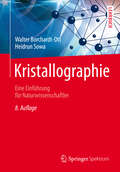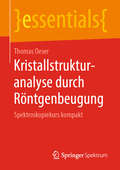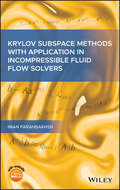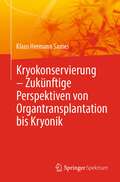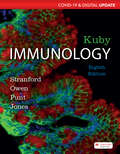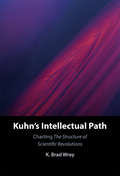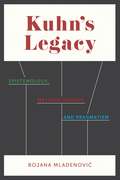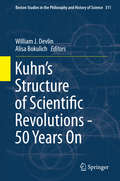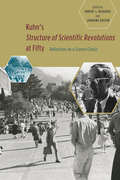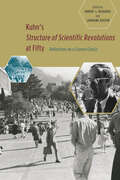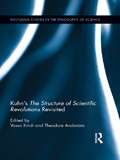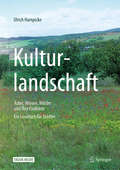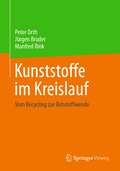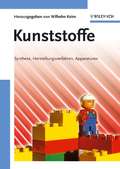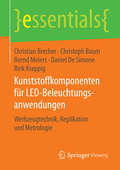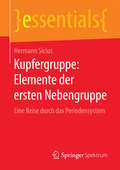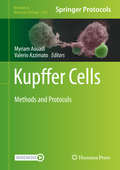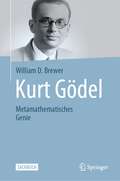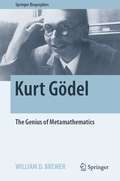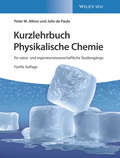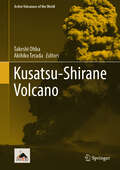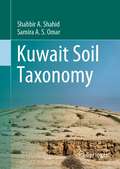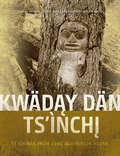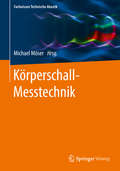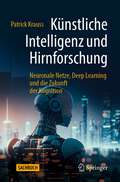- Table View
- List View
Kristallographie: Eine Einführung für Naturwissenschaftler
by Heidrun Sowa Walter Borchardt-OttDieses eingeführte Lehrbuch basiert auf Vorlesungen an der Westfälischen Wilhelms- Universität Münster, an der TU Berlin und an der Georg-August-Universität Göttingen. Der Schwerpunkt des Buches liegt bei der geometrischen Kristallographie. Vom Raumgitter ausgehend werden Symmetrieoperationen, Bravais-Gitter, Raum- und Punktgruppen abgehandelt. Die Betrachtung der Raumgruppen ist in dieser 8. Auflage um eine kurze Einführung in die Beziehungen zwischen Symmetriegruppen und deren Anwendung erweitert worden. Es folgen Kapitel über Kristallchemie und röntgenographische Untersuchungen. Die einzelnen Kapitel schließen mit zahlreichen Übungsaufgaben, deren Lösungen angegeben sind.
Kristallstrukturanalyse durch Röntgenbeugung: Spektroskopiekurs kompakt (essentials)
by Thomas OeserThomas Oeser bietet in diesem essential eine leicht verständliche Einführung in die Kristallstrukturanalyse durch Röntgenbeugung. Kurz und präzise, strukturiert und gut zu lesen vermittelt er die Grundlagen dieses Analyseverfahrens. Von den Methoden der Röntgenanalytik und den typischen Anwendungsbeispielen der Kristallstrukturanalyse führt der Autor zu einem detaillierten Verständnis der Einkristall-Röntgenstrukturanalyse. Er gibt dafür einen Überblick über Grundlagen zur charakteristischen Röntgenstrahlung, Netzebenen sowie dem reziproken Gitter und erläutert damit Strukturlösung und -verfeinerung. Ein Kapitel zu den Symmetrieeigenschaften und der Nomenklatur von Kristallsystemen sowie weiterführende Literatur runden das Buch ab.
Krylov Subspace Methods with Application in Incompressible Fluid Flow Solvers
by Iman FarahbakhshA succinct and complete explanation of Krylov subspace methods for solving matrices Krylov Subspace Methods with Application in Incompressible Fluid Flow Solvers is the most current and complete guide to the implementation of Krylov subspace methods for solving systems of equations with different types of matrices. Written in the simplest language possible and eliminating ambiguities, the text is easy to follow for post-grad students and applied mathematicians alike. The book covers a breadth of topics, including: The different methods used in solving the systems of equations with ill-conditioned and well-conditioned matrices. The behavior of Krylov subspace methods in the solution of systems with ill-posed singular matrices The book includes executable subroutines and main programs that can be applied in CFD codes as well as appendices that support the results provided throughout the text. There is no other comparable resource to prepare the reader to use Krylov subspace methods in incompressible fluid flow solvers.
Kryokonservierung - Zukünftige Perspektiven von Organtransplantation bis Kryonik
by Klaus Hermann SamesDieses Buch bietet einen Überblick über die Kryobiologie, einen Teilbereich der biomedizinischen Forschung, der sich seit vielen Jahren mit der Lebenserhaltung durch Kälte beschäftigt. Zum Beispiel werden Zellkulturen und winzige Gewebeproben bei kryogenen Temperaturen (unter etwa -90°C) aufbewahrt. Eine Wiederbelebung von Organen ist bisher fast ausschließlich nach einer Kühlung auf Temperaturen von 0 bis -80°C gelungen und heute noch Gegenstand der Forschung. Der aktuelle Forschungsstand wird hier zusammengefasst und für verschiedene Tierarten und konkrete Anwendungsbereiche dargelegt. Vor allem wird auf große biologische Einheiten, wie z. B. menschliche Organe und, als Fernziel, den ganzen menschlichen Organismus, eingegangen. Es werden die Notwendigkeit sowie die Möglichkeiten für die Vermeidung von Eiskristallen und Stressfrakturen während der Kühlung auf kryogene Temperaturen erklärt, um eine sichere Lagerung zu ermöglichen.Neuere Methoden werden vorgestellt, die versuchen mit geringstmöglichen Konzentrationen von Frostschutzmitteln auszukommen, da diese Nebenwirkungen verursachen aber benötigt werden, um die Kristallisierung, wie auch die Stressfrakturen geringzuhalten.Dieses Buch richtet sich an Personen, die sich über das Feld der Kryobiologie informieren möchten und dessen Fortschritte, Einsatzmöglichkeiten, aber auch die momentanen Limitierungen kennen lernen möchten.
Kuby Immunology Covid-19 & Digital Update
by Patricia Jones Jenni Punt Judy Owen Sharon StranfordThe hallmark resource for immunology students returns in a special update that accounts for COVID-19 and offers powerful new digital resources.
Kuhn's Intellectual Path: Charting The Structure of Scientific Revolutions
by K. Brad WrayThomas Kuhn's The Structure of Scientific Revolutions offers an insightful and engaging theory of science that speaks to scholars across many disciplines. Though initially widely misunderstood, it had a profound impact on the way intellectuals and educated laypeople thought about science. K. Brad Wray traces the influences on Kuhn as he wrote Structure, including his 'Aristotle epiphany', his interactions, and his studies of the history of chemistry. Wray then considers the impact of Structure on the social sciences, on the history of science, and on the philosophy of science, where the problem of theory change has set the terms of contemporary realism/anti-realism debates. He examines Kuhn's frustrations with the Strong Programme sociologists' appropriations of his views, and debunks several popular claims about what influenced Kuhn as he wrote Structure. His book is a rich and comprehensive assessment of one of the most influential works in the modern sciences.
Kuhn's Legacy: Epistemology, Metaphilosophy, and Pragmatism
by Bojana MladenovićThomas Kuhn’s The Structure of Scientific Revolutions is one of the most important books of the twentieth century. Its influence reaches far beyond the philosophy of science, and its key terms, such as “paradigm shift,” “normal science,” and “incommensurability,” are now used in both academic and public discourse without any reference to Kuhn. However, Kuhn’s philosophy is still often misunderstood and underappreciated. In Kuhn’s Legacy, Bojana Mladenović offers a novel analysis of Kuhn’s central philosophical project, focusing on his writings after Structure.Mladenović argues that Kuhn’s historicism was always coupled with a firm and consistent antirelativism but that it was only in his mature writings that Kuhn began to systematically develop an original account of scientific rationality. She reconstructs this account, arguing that Kuhn sees the rationality of science as a form of collective rationality. At the purely formal level, Kuhn’s conception of scientific rationality prohibits obviously irrational beliefs and choices and requires reason-responsiveness as well as the uninterrupted pursuit of inquiry. At the substantive, historicized level, it rests on a distinctly pragmatist mode of justification compatible with a notion of contingent but robust scientific progress. Mladenović argues that Kuhn’s epistemology and his metaphilosophy both represent a creative and fruitful continuation of the tradition of American pragmatism. Kuhn’s Legacy demonstrates the vitality of Kuhn’s philosophical project and its importance for the study of the philosophy and history of science today.
Kuhn's Structure of Scientific Revolutions - 50 Years On
by Alisa Bokulich William J. DevlinIn 1962, the publication of Thomas Kuhn's Structure 'revolutionized' the way one conducts philosophical and historical studies of science. Through the introduction of both memorable and controversial notions, such as paradigms, scientific revolutions, and incommensurability, Kuhn argued against the traditionally accepted notion of scientific change as a progression towards the truth about nature, and instead substituted the idea that science is a puzzle solving activity, operating under paradigms, which become discarded after it fails to respond accordingly to anomalous challenges and a rival paradigm. Kuhn's Structure has sold over 1. 4 million copies and the Times Literary Supplement named it one of the "Hundred Most Influential Books since the Second World War. " Now, fifty years after this groundbreaking work was published, this volume offers a timely reappraisal of the legacy of Kuhn's book and an investigation into what Structure offers philosophical, historical, and sociological studies of science in the future.
Kuhn's Structure of Scientific Revolutions at Fifty
by Robert J. Richards Lorraine DastonThomas S. Kuhn's The Structure of Scientific Revolutions was a watershed event when it was published in 1962, upending the previous understanding of science as a slow, logical accumulation of facts and introducing, with the concept of the "paradigm shift," social and psychological considerations into the heart of the scientific process. More than fifty years after its publication, Kuhn's work continues to influence thinkers in a wide range of fields, including scientists, historians, and sociologists. It is clear that The Structure of Scientific Revolutions itself marks no less of a paradigm shift than those it describes. In Kuhn's "Structure of Scientific Revolutions" at Fifty, leading social scientists and philosophers explore the origins of Kuhn's masterwork and its legacy fifty years on. These essays exhume important historical context for Kuhn's work, critically analyzing its foundations in twentieth-century science, politics, and Kuhn's own intellectual biography: his experiences as a physics graduate student, his close relationship with psychologists before and after the publication of Structure, and the Cold War framework of terms such as "world view" and "paradigm."
Kuhn's Structure of Scientific Revolutions at Fifty: Reflections on a Science Classic
by Lorraine Daston Robert J. Richards and Lorraine DastonThomas S. Kuhn’s The Structure of Scientific Revolutions was a watershed event when it was published in 1962, upending the previous understanding of science as a slow, logical accumulation of facts and introducing, with the concept of the “paradigm shift,” social and psychological considerations into the heart of the scientific process. More than fifty years after its publication, Kuhn’s work continues to influence thinkers in a wide range of fields, including scientists, historians, and sociologists. It is clear that The Structure of Scientific Revolutions itself marks no less of a paradigm shift than those it describes. In Kuhn’s “Structure of Scientific Revolutions” at Fifty, leading social scientists and philosophers explore the origins of Kuhn’s masterwork and its legacy fifty years on. These essays exhume important historical context for Kuhn’s work, critically analyzing its foundations in twentieth-century science, politics, and Kuhn’s own intellectual biography: his experiences as a physics graduate student, his close relationship with psychologists before and after the publication of Structure, and the Cold War framework of terms such as “world view” and “paradigm.”
Kuhn's The Structure of Scientific Revolutions Revisited (Routledge Studies in the Philosophy of Science)
by Theodore Arabatzis Vasso KindiThe year 2012 marks the 50th anniversary of the publication of Thomas S. Kuhn’s The Structure of Scientific Revolutions. Up until recently, the book’s philosophical reception has been shaped, for the most part, by the debates and the climate in philosophy of science in the 1960s and 1970s; this new collection of essays takes a renewed look at this work. This volume concentrates on particular issues addressed or raised in light of recent scholarship and without the pressure of the immediate concerns scholars had at the time of the Structure’s publication. There has been extensive research on all of the major issues concerning the development of science which are discussed in Structure, work in which the scholars contributing to this volume have all been actively involved. In recent years they have pursued novel research on a number of topics relevant to Structure’s concerns, such as the nature and function of concepts, the complexity of logical positivism and its legacy, the relation of history to philosophy of science, the character of scientific progress and rationality, and scientific realism, all of which are brought together and given new light in this text. In this way, our book makes new connections and undertakes new approaches in an effort to understand the Structure’s significance in the canon of philosophy of science.
Kulturlandschaft - Äcker, Wiesen, Wälder und ihre Produkte: Ein Lesebuch für Städter
by Ulrich HampickeDieses Buch gibt einen detaillierten Überblick über die Kulturlandschaften Mitteleuropas einschließlich des Waldes und wie diese durch den Menschen und seine Wirtschaft entstanden und geprägt wurden. Der Leser erfährt, wie die moderne Produktion in der Landwirtschaft aussieht und welche Probleme durch diese Produktion und unseren Konsum entstehen. In diesem Zusammenhang wird auf die Agrarpolitik und den Außenhandel eingegangen. Neben ökonomisch-politischen Themen erklärt der Autor auch die biologischen Zusammenhänge und Auswirkungen unserer Landwirtschaft. So geht er neben anderen Themen besonders auf dem Verlust der Biodiversität und die Desorganisation der Stoffkreisläufe in der Agrarlandschaft ein. Im zweiten Teil des Buches werden Lösungen zu den Problemen und Perspektiven aufgezeigt. Dabei werden zuerst die Ansätze auf politischer Ebene beleuchtet und danach auf Initiativen auf anderen Ebenen eingegangen. Dieses Buch wendet sich an alle, die sich über die moderne Landwirtschaft informieren und die Hintergründe aktueller Debatten verstehen möchten.
Kunststoffe im Kreislauf: Vom Recycling zur Rohstoffwende
by Jürgen Bruder Peter Orth Manfred RinkDie Autoren führen den Leser in die komplexe Welt der Kunststoffwirtschaft ein, denken deren Zirkularität konsequent zu Ende und zeigen auf, wie eine ganzheitliche und integrative Kreislaufstrategie aussehen kann. Prof. Martin StuchteyEine treibhausgasneutrale und ressourceneffiziente Gesellschaft basiert auf zwei essenziellen Säulen: regenerativen Energieträgern und recycelten Rohstoffen – die Energiewende braucht die Rohstoffwende. Prof. Martin FaulstichDie Lebenszyklus-Perspektive auf Kunststoffe ermöglicht eine «Win-Win»-Situation: zirkuläre ersetzen fossile Rohstoffe, die nicht mehr in der Umwelt landen. Konsequent müssen wir in zirkuläre statt fossiler Rohstoffe investieren. Prof. André BardowDie Vision der zirkulären Wertschöpfung ist nur umsetzbar, wenn Kunststoffkreisläufe systematisch und konsequent geschlossen werden. Das erfordert eine tiefgreifende industrielle Transformation zur zirkulären Kunststoffwirtschaft. Ralph AppelDer Leser erhält Angaben zur Einschätzung von Produktionsvolumina, Marktgrößen, Emissionen, Abfallmengen. Die systematische Befassung mit technischen, wirtschaftlichen und ökologischen Aspekten ist Grundlage von Analysen und für die Umsetzung in Wirtschaft und Gesellschaft.
Kunststoffe: Synthese, Herstellungsverfahren, Apparaturen
by Wilhelm Keim Herausgegeben VonAls Kunststoffe werden hochmolekulare Substanzen bezeichnet, aus denen sich mittels geeigneter Verarbeitungsprozesse Formkörper herstellen lassen, die bei Raumtemperatur hart und steif sind. Sie zählen wie Fasern, Folien, Elastomere, Schaumstoffe, Lacke und Klebstoffe zu der umfangreichen Klasse der Polymerwerkstoffe. Die namhaften Autoren aus Industrie und Hochschulen beschreiben Synthesemethoden, Apparaturen zur Konfektionierung und Verfahren zur Herstellung der wichtigsten Kunststoffe sowie die Verarbeitung von thermoplastischen Formmassen. Ein modernes Werk für Chemieingenieure, Verfahrenstechniker, Technische Chemiker, Polymerchemiker und Materialwissenschaftler sowie für Studenten dieser Fachrichtungen.
Kunststoffkomponenten für LED-Beleuchtungsanwendungen: Werkzeugtechnik, Replikation und Metrologie (essentials)
by Christian Brecher Christoph Baum Bernd Meiers Daniel Simone Reik KrappigDieses essential befasst sich mit denProzessketten zur Herstellung optischer Komponenten fürLED-Beleuchtungsanwendungen. Mit Blick auf eine wirtschaftliche Fertigung derKomponenten gehen die Autoren besonders auf die Möglichkeiten zurkostengünstigen Replikation durch Kunststoffspritzguss oderRolle-zu-Rolle-Prozesse ein. Sie thematisieren die notwendigenFertigungsschritte für die Werkzeugherstellung genauso wie die messtechnischeCharakterisierung der Kunststoffkomponenten. Dabei zeigen sie die notwendigeMaschinen- und Werkzeugtechnik, mögliche Verfahrensvarianten, die verwendetenMaterialien und entsprechende Beispielgeometrien auf.
Kupfergruppe: Eine Reise durch das Periodensystem (essentials)
by Hermann SiciusHermann Sicius stellt ausf#65533;hrlich die Elemente der ersten Nebengruppe (Kupfer, Silber, Gold, Roentgenium) vor, deren physikalische und chemische Eigenschaften relativ #65533;hnlich sind. Kupfer, Silber und Gold sind bereits seit Jahrtausenden bekannt. Beim Elementenpaar Silber und Gold ist die Lanthanoidenkontraktion nur noch abgeschw#65533;cht erkennbar. Die jeweiligen physikalischen Eigenschaften von Kupfer, Silber und Gold #65533;hneln sich bis auf die von Kupfer zu Gold zunehmende Dichte, daf#65533;r nimmt - wie auch schon bei den Elementen der vierten bis zehnten Nebengruppe - die Reaktivit#65533;t vom Kopfelement (hier: Kupfer) zum schwersten Gruppenmitglied (hier: Gold) zu. Auch Kupfer ist aber schon ein Halbedelmetall. Bei Kupfer sind die Oxidationsstufen +1 und +2 am stabilsten, bei Silber +1 und bei Gold +1 und +3. Erst 1994 konnte das erste Atom des Roentgeniums erzeugt werden.
Kupffer Cells: Methods and Protocols (Methods in Molecular Biology #2164)
by Myriam Aouadi Valerio AzzimatoThis volume provides a complete overview of kupffer cell biology, from isolation to phenotyping. Chapters guide readers through methods and protocols on phenotyping, including RNA sequencing, Mass cytometry and 3D microscopy, as well as gene manipulation in vivo, and disease models from fatty liver disease to cancer. Written in the highly successful Methods in Molecular Biology series format, chapters include introductions to their respective topics, lists of the necessary materials and reagents, step-by-step, readily reproducible laboratory protocols, and tips on troubleshooting and avoiding known pitfalls. Authoritative and cutting-edge, Kupffer Cells: Methods and Protocols aims to ensure successful investigation of this growing field.
Kurt Gödel: Metamathematisches Genie
by William D. BrewerZu seinen Lebzeiten war Kurt Gödel außerhalb der Fachwelt der Mathematiker, Philosophen und theoretischen Physiker kaum bekannt. Zu Beginn seiner Karriere schuf er beeindruckende Arbeiten zur Vollständigkeit und Beweisbarkeit formaler logischer Systeme, die zu seiner Dissertation und seiner Habilitations-schrift wurden und ihn unter Fachleuten weltberühmt machten. Seine Unvoll-ständigkeitssätze läuteten das Ende der formal-logischen Programme der Logizisten (Russell et al.) und der Formalisten (Hilbert et al.) ein. Später erzielte er auch signifikante Ergebnisse in der Mengenlehre. Nach seiner Emigration in die USA (Princeton), widmete er sich mehr der Philosophie, dem Leitmotiv seines Lebens, und er fand auch eine einzigartige Lösung zu Einsteins Feld-gleichungen der Gravitation, sein “Gödel-Universum“. Dieses Buch beschreibt sowohl den Gödel, der ein genialer Wissenschaftler war, und der gewagte und neuartige Hypothesen zu den Fundamenten der Mathe-matik und Physik hervorbrachte, ‒ als auch den Gödel, der ein perfekter Rationalist war, aber sein Alltagsleben nur mit Mühe meistern konnte und zeitlebens unter Depressionen, Angstneurosen und Hypochondrie litt. Ein Leben voller Paradoxen, in dem er trotz all seiner psychischen Probleme Beachtliches leistete und zu einem Vorbild für viele jüngere Wissenschaftler wurde. Das Buch liefert den Kontext zu seinen Errungenschaften, die ein verblüffend breites Spektrum intellektueller Unternehmungen darstellen, und zu seiner zunehmenden Geisteskrankheit; und es zeigt, wie er eine lange und erfolgreiche Karriere mit Hilfe seiner loyalen Ehefrau Adele und einigen seiner Freunde durchlaufen konnte. Dies ist eine faszinierende Geschichte der wissen-schaftlichen Genialität und der menschlichen Natur.
Kurt Gödel: The Genius of Metamathematics (Springer Biographies)
by William D. BrewerDuring his lifetime, Kurt Gödel was not well known outside the professional world of mathematicians, philosophers and theoretical physicists. Early in his career, for his doctoral thesis and then for his Habilitation (Dr.Sci.), he wrote earthshaking articles on the completeness and provability of mathematical-logical systems, upsetting the hypotheses of the most famous mathematicians/philosophers of the time. He later delved into theoretical physics, finding a unique solution to Einstein’s equations for gravity, the ‘Gödel Universe’, and made contributions to philosophy, the guiding theme of his life. This book includes more details about the context of Gödel’s life than are found in earlier biographies, while avoiding an elaborate treatment of his mathematical/scientific/philosophical works, which have been described in great detail in other books. In this way, it makes him and his times more accessible to general readers, and will allow them to appreciate the lasting effects of Gödel’s contributions (the latter in a more up-to-date context than in previous biographies, many of which were written 15–25 years ago). His work spans or is relevant to a wide spectrum of intellectual endeavor, and this is emphasized in the book, with recent examples. This biography also examines possible sources of his unusual personality, which combined mathematical genius with an almost childlike naiveté concerning everyday life, and striking scientific innovations with timidity and hesitancy in practical matters. How he nevertheless had a long and successful career, inspiring many younger scholars along the way, with the help of his loyal wife Adele and some of his friends, is a fascinating story in human nature.
Kurzlehrbuch Physikalische Chemie: für natur- und ingenieurwissenschaftliche Studiengänge
by Peter W. Atkins Julio de PaulaMit seinem lebendigen und anschaulichen Stil sowie einer immer weiter verfeinerten Didaktik hat Peter Atkins das Lernen und Lehren in der Physikalischen Chemie revolutioniert. Sein Stil ist unverwechselbar - und unerreicht. Die vollständige überarbeitete Neuauflage umfasst die kompletten Grundlagen des Fachs für Bachelor-Studenten und Nebenfächler und zeigt spannende Verbindungen zu anderen Gebieten der Chemie sowie zur Physik und Biologie auf. Kurz und gut: Der 'kleine' Atkins ist und bleibt ein Muss für jeden Einsteiger in die Physikalische Chemie.
Kusatsu-Shirane Volcano (Active Volcanoes of the World)
by Takeshi Ohba Akihiko TeradaThis volume presents a comprehensive overview of Mt. Kusatsu-Shirane, one of the most active volcanoes in Japan in terms of persistent release of volatile as volcanic gas and hot springs. The unexpected eruption of Kusatsu-Shirane volcano on January 23, 2018, caused human damages. It shed light on the difficulty of the prediction of phreatic eruptions, whereas motivated studies on schemes for volcano monitoring, research and disaster mitigation of the dormant volcanoes. This book includes the past and on-going research on the Kusatsu-Shirane volcano with varieties of disciplines such as seismology, geodesy, geomagnetism, geochemistry, petrology, and social science research on reporting of the eruption in 2018.
Kuwait Soil Taxonomy
by Shabbir A. Shahid Samira A. OmarThis book provides guidelines to key soil taxa in the deserts of Kuwait and guidance to associated procedures for laboratory analyses of soils, leading to land use planning on informed decisions. Soils are essential to provide food, feed, and fiber in addition to multiple ecosystem services that sustain life on earth. To achieve the above services sustainably, it is essential to use soils rationally based on their potential for specific uses. This requires establishing national soil classification systems to assess soils locally and to provide guidance to other countries where similar soils may be occurring. Once soil classification is established, it becomes easier to adopt technologies established on similar soils and environmental conditions without conducting long-term and expensive experimental trial. The taxa are established based on soil’s morphological, physical, chemical, and mineralogical properties and climatic factors. It offers opportunities to maintain future soil surveys and their correlation to the soils of Kuwait. The book is useful in other arid region countries where similar soil and environmental conditions are existing, such as Bahrain, Oman, Qatar, and Saudi Arabia. The book also has international relevance, as it was prepared by extracting definitions from USDA-NRCS keys to soil taxonomy, and sections related to soils of Kuwait are added in the book. The book is a unique and excellent addition to the international soil literature.
Kwäday Dän Ts'ìnchi: Teachings from Long Ago Person Found
by Richard J. Hebda Sheila A. Greer Alexander P. MackieOn a late summer day, many years ago, a young man set out on a voyage through the mountains. He never reached his destination. When his remains were discovered by three British Columbia hunters, roughly three hundred years after he was caught by a storm or other accident, his story had faded from even the long memory of the region's people. First Nations elders decided to call the discovery Kwäday Dän Ts'ìnchi—Long Ago Person Found. The discovery of the Kwäday Dän Ts'ìnchi man raised many questions. Who was he and how did he die? Where had he come from? Where was he going, and for what purpose? What did his world look like? But his remains, preserved in glacial ice for centuries, offered answers, too—as did the traditional knowledge and experience of the Indigenous peoples in whose territories he lived and died. In this comprehensive and collaborative account, scientific analysis and cultural knowledge interweave to describe a life that ended just as Europeans were about to arrive in the northwest. What emerges is not only a portrait of an individual and his world, but also a model for how diverse ways of knowing, in both scholarly and oral traditions, can complement each other to provide a new understanding of our complex histories.
Körperschall-Messtechnik (Fachwissen Technische Akustik)
by Michael MöserDieser Band der Reihe Fachwissen Technische Akustik definiert, neben einer allgemeinen Erläuterung über Sinn und Zweck der Körperschall-Messtechnik, zunächst die relevanten Messgrößen. Danach wird auf die verschiedenen Wandlerprinzipien, deren Eigenschaften und Bauformen eingegangen, wobei im Focus piezoelektrische Anwendungen in Form von Beschleunigungs-, Kraft- und Impedanzsensoren stehen. Ein extra Abschnitt ist den Drehschwingungen und ihrer Erfassung gewidmet. Weitere Abschnitte behandeln die Körperschallintensität sowie die Möglichkeiten der elektrodynamischen und impulsförmigen künstlichen Körperschallanregung von Strukturen.
Künstliche Intelligenz und Hirnforschung: Neuronale Netze, Deep Learning und die Zukunft der Kognition
by Patrick KraussWie funktioniert Künstliche Intelligenz (KI) und gibt es Parallelen zum menschlichen Gehirn? Was sind die Gemeinsamkeiten von natürlicher und künstlicher Intelligenz, und was die Unterschiede? Ist das Gehirn nichts anderes als ein biologischer Computer? Was sind Neuronale Netze und wie kann der Begriff Deep Learning einfach erklärt werden?Seit der kognitiven Revolution Mitte des letzten Jahrhunderts sind KI und Hirnforschung eng miteinander verflochten. Im Bereich der KI gab es in den letzten Jahren mehrere spektakuläre Durchbrüche, von alphaGo über DALL-E 2 bis ChatGPT, die so bis vor kurzem noch völlig undenkbar waren. Doch schon heute arbeiten Forscher an den Innovationen von morgen, wie hybrides maschinelles Lernen oder neuro-symbolische KI. Aber was verbirgt sich dahinter überhaupt?Anhand aktueller Forschungsergebnisse und spannender Beispiele aus der Praxis bietet dieses Sachbuch einen verständlichen Einstieg in die Grundlagen und Herausforderungen dieser faszinierenden Disziplinen. Sie erfahren, was Neurowissenschaft und Psychologie über die Funktionsweise des Gehirns wissen und wie Künstliche Intelligenz arbeitet. Lernen Sie zudem, wie KI unser Verständnis des Gehirns revolutioniert hat und wie Erkenntnisse aus der Hirnforschung umgekehrt in der Informatik eingesetzt werden, um KI-Algorithmen weiterzuentwickeln. Entdecken Sie die faszinierende Welt dieser beiden Disziplinen. Erfahren Sie, warum Künstliche Intelligenz und Hirnforschung zwei Seiten einer Medaille sind und wie sie unsere Zukunft prägen werden.
